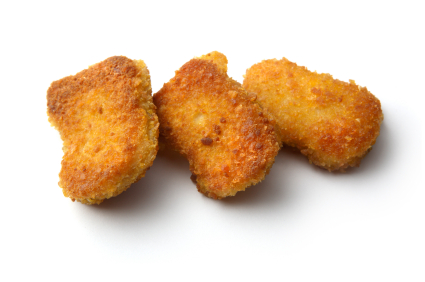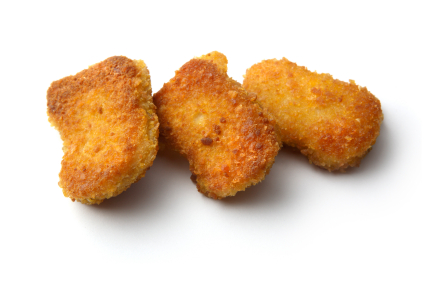When my info-larder gets too packed, it’s time to serve up some choice nuggets from around the Web.
 Get’em while they’re hot.BP oil infiltrates the Gulf’s food chain
Get’em while they’re hot.BP oil infiltrates the Gulf’s food chain
The inevitable has happened. From a McLatchy article:
University scientists have spotted the first indications oil is entering the Gulf seafood chain — in crab larvae — and one expert warns the effect on fisheries could last “years, probably not a matter of months” and affect many species.
Of course, oil in crab larvae means oil in any fish that feed on crab larvae — a first step of hydrocarbons concentrating up the food chain, from little drops in little fish to big drops in big fish. And that’s not the only way Gulf sea life will come into contact with BP’s spilled oil, as veteran fishery expert Harriet Perry tells McLatchey. She says plankton feeders like menhaden will “just take it in,” making it available for their predators. She adds:
We have also just started seeing it on the fins of small, larval fish — their fins were encased in oil. That limits their mobility, so that makes them easy prey for other species. The oil’s going to get into the food chain in a lot of ways.
What does this mean for food safety? Exposure to petroleum in food has been shown to cause cancer and brain damage, so keeping fish tainted with it out of the food supply is key. Right now, huge swaths of the Gulf’s teeming fisheries are closed for business. And the catch from the parts that remain open are subject to rigorous testing. So, if you see Gulf seafood for sale at a market, it’s likely to be as safe to eat as anything emerging from the troubled sea.
However, as Andrew Schneider shows in a recent AOL News investigation, the public and the press need to maintain heavy pressure on food-safety officials to ensure that fish harvested from spill-affected waters is safe to eat. Schneider suggests that while the testing of market-bound Gulf seafood is indeed rigorous — and no tainted specimens have been found among market-bound fish — questions remain about precisely what level of oil contamination makes seafood unsafe.
Corn, immigration, and drug violence
In a recent Nation, veteran Latin America watcher Peter Canby has a long, searching essay corn, NAFTA, genetically modified organisms (GMOs), Mexican smallholder farmers, and the fate of agriculture in a warming world.
The piece details the well-known story of how highly subsidized U.S. corn flooded Mexico after the passage of NAFTA in 1994, helping spark an exodus from the countryside, particularly in Mexico’s south. But it also makes a couple of points that don’t get nearly enough attention. Given all the hysteria around immigration, and the horrific recent headlines about Mexico’s narco-trafficking crisis, it’s worth laying them out.
- In the late 1980s, blessed by the IMF and friends in the Bush I administration, Mexico president Carlos Salinas embarked upon a policy of descampesinoización — pushing smallholder farmers off of the land and into the cities to staff an export-led manufacturing boom. Salinas’ aggressive push for NAFTA, and the decision to subject Mexico’s smallholder farmers to its rigors by including corn in the pact, were part of that plan.
- The manufacturing boom never materialized: China, not Mexico, became the United States’ de facto manufacturing zone. The drug trade and opportunities in the United States largely filled the void. So now Mexico has a massive, metastasizing drug-violence problem, and the United States has what nativists believe to be an “immigration crisis.” Connecting these dots — Salinas’ attack on campesinos (smallholder farmers), NAFTA, the U.S. “immigration crisis,” and Mexico’s drug-trafficking nightmare — does not happen nearly enough in the U.S. press.
Canby’s essay also has some great stuff on traditional campesino farming, and how an annual flood of U.S. GMO corn threatens to snuff out one of the globe’s most important food resources: the stunning diversity of corn varieties cultivated in Mexico’s south. It is worth reading in its entirety. Also worth reading on this general theme: In the Boston Review, Sarah Hill has an excellent piece on how the border town of Jaurez, once hailed as a great manufacturing center for U.S.-bound electronics products, has instead become a war zone for rival narco-trafficking interests, some of them, evidently, supported by the Mexican government itself.
Something fishy in the state of Norway
From an English-language paper in Norway comes a report that some French journalists have concluded that farmed Norwegian salmon is toxic, nasty stuff. According to the article, the journalists did some gonzo reporting to reach that conclusion:
The journalists followed an individually-calculated diet of daily food for a few weeks, and reached their conclusions after having been constantly tested at an independent laboratory.
Precisely what those tests found, the article does not make clear. But evidently, France’s Minister of Food, Agriculture and Fishing took the claims seriously enough to declare himself “shocked” and “revolted.” The ministry is now formally posing questions to Norway about the use of pesticides to control sea lice, which tend to proliferate in factory-style salmon operations.
Why should we care on this side of the Atlantic? Because Norwegian companies own and operate most of the industrial-scale salmon farms in the United States and Canada. In his 2008 book Bottomfeeder, Taras Grescoe shows that three enormous Norwegian firms dominate North American salmon farming. One of them, Marine Harvest, alone owns as much as 30 percent of the global farmed-salmon market. Anyone game to conduct similar guerrilla experiments here? Not it! I won’t go near the stuff — I gave up farmed salmon years ago.
U.N. panel says sustainable farming practices can “feed the world”
The planet is due to add an additional 3 billion people by 2050, and only chemical-intensive agriculture, goosed with novel transgenic seeds, can possibly hope to feed them all. That’s the agrichemical industry’s mantra, anyway, and it has congealed into conventional wisdom.
But among ag experts, the premise is widely disputed. In fact, many experts think the ramping up of industrial agriculture will be disastrous for the environment, and instead promote “agrocecological” practices that can produce plenty of food while also polluting much less.
That was the message delivered at a meeting in June convened by U.N. Special Rapporteur on the Right to Food Olivier De Schutter.
So what is agrocecology? According to a U.N. report on the event, agroecological techniques include “agroforestry (planting trees and crops on the same parcel), biological control of pests and diseases through the use of natural predators, water harvesting methods, intercropping, green manure cover crops, mixed crops, livestock management, and a range of additional practices.” In other words, essentially what we think of as organic agriculture, without the rigorous codification.
Such farming styles don’t have a PR machine behind them, unlike patented biotech seeds. Yet their success has been proven, as the U.N. report shows:
The widest study ever conducted on the subject found that agroecological approaches resulted in an average crop yield gain of 79 per cent. The study covered 286 projects in 57 developing countries, representing a total surface of 37 million hectares.
Such “agroecological success stories” abound in Africa. In Tanzania, where the western provinces of Shinyanga and Tabora were once known as the “Desert of Tanzania,” agroforestry techniques and participatory processes allowed some 350,000 hectares of land to be rehabilitated in two decades. Profits per household rose by up to $500 a year. Similar techniques are being used successfully in Malawi.
Advocates for agroecology don’t lack success stories; they lack the sort of political power that comes with a multi-billion-dollar industry like agrichemicals. You can’t patent a technique like cover cropping; and if you can’t patent something, you likely can’t leverage it for cash to hire lobbyists. As De Schutter put it, “What is needed now is political will to move from successful pilot projects to nationwide policies.” Which is precisely the point of my own recent post about “why eaters alone can’t transform the food system.”



